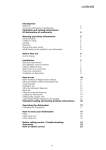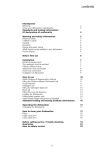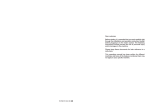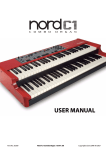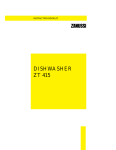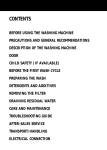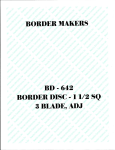Download Beko DWD5410 Specifications
Transcript
contents Introduction Welcome Know your dishwasher / specification Standards and testing information / EC declaration of conformity 2 4 4 Warning and safety information Electrical Safety Childrens safety General Recycling Energy and water saving What should not be washed in your dishwasher 5 5 5 5 6 6 6 Before first use Hot Air Drying 6 6 Installation Electrical requirements This appliance must be earthed Fitting a different plug Water inlet hose connection Drain hose connection Installation of dishwasher 7 7 7 7 8 8 9 How to use Water hardness & Regeneration settings Filling the (Water softener) Dishwasher salt Detergent use Filling the detergent dispenser Rinse aid Filling the rinse aid dispenser Loading the Dishwasher Folding plate support rods Upper basket height adjustment (Unloaded) Standard loading and testing institute information 10 10 11 12 12 13 13 14 14 15 16 Operating the dishwasher Unloading the Dishwasher 17 17 How to clean your Dishwasher Filters Upper spray arm Lower spray arm 17 18 18 18 Before calling service / Trouble shooting Guarantee How to obtain service 19 23 23 3 Removable work top Hot Air Drying Upper spray arm Upper basket Upper basket track latch Heating element concealed behind the liner Dishwasher salt cap Lower spray arm Lower basket Cutlery basket Filters Detergent and Rinse aid dispenser Removable kick plate Programme Selection&Starting Guide On / off indicator light Rinse aid level indicator light & Programme starting point Salt level indicator light Progress indicator lights On / Off 1 Wash Rinse Aid 2 Salt End 1 PRE-WASH No Heat 3 2 ECONOMY 50°C RAPID 35°C 5 4 NORMAL 60°C INTENSIVE 70°C Start / Stop 3 4 5 Programme Knob Door Handle Start / Stop button On/Off button specification Load Capacity Height Width Depth Depth/Height (without worktop) : 12 Place settings : 850 mm : 598 mm : 598 mm Net weight Supply voltage Fuse currrent Total power Heater power Pump powers : 51 kg : 220-240 V ~ 50 Hz : 13 A : 1900-2200 W : 2000 W : 125/30 W Diameter of plates for : Upper basket : 25 cm max. Lower basket : 31 cm max. Because we continually strive to improve our products, we may change our specifications and designs without prior notice. : 570 mm / 820 mm This appliance has been designed, constructed and distributed in compliance with the safety requirements of EC directives. Load capacity : 12 place settings. 4 73/23/EC 89/336/EC 93/68/EC IEC 436/DIN 44990 EN 50242 Warning ! The dishwasher should only be operated on the voltage specified. For electrical safety, only earthed plugs and sockets should be used. Always use the fused plug provided with the appliance. The user is responsible for meeting these basic safety requirements. The life of your machine and your safety depend on you using an electrical installation compliant to standards. Long cutlery, such as ladles and long knives, etc must be placed horizontally on top of the full cutlery basket or on the racks to prevent accidental injury. The appliance is not intended for use by young children or infirm persons without supervision. Do not use an extension cable. This dishwasher has been designed to clean your dirty dishes at home. When disconnecting your machine from the mains supply, always pull from the plug. Never pull the cord itself. Never use chemical solvents in your machine; this may lead to explosion risk. Never allow your children to play with your dishwasher. Never use materials other than specially produced softening salts in the salt dispenser of your machine. Dishwasher detergents contain irritants and abrasives. These ingredients might have caustic effects in the eyes, mouth and throat. They can be extremely dangerous if swallowed. Avoid contact with skin and eyes. Check that the detergent receptacle is empty after completion of the wash cycle. Never use materials other than specially produced detergents and rinse-aids in the detergent and rinse aid dispensers of your machine. Please dispose of the packaging material and old appliances carefully. Please ensure old machines do not become a threat to child safety. It is known that children lock themselves in unused machines. To avoid such a problem it is advised that you cut the mains cable off and break the door latch so it does not lock. Keep detergents out of childrens reach and do not put detergent in the machine until right before you start the washing programme. The water in your dishwasher is not suitable for drinking, for this reason do not allow your children near your machine when the front door is open. The door of your machine is designed to support the weight of a full basket when the lower basket is pulled all the way out. Never place any other load on the door, otherwise the machine may tip over. Never allow your children to play on or sit onto the front door when the front door is open. After using the dishwasher always close the door as an open door can be a hazard. After unpacking your machine, keep the packing material out of childrens reach. Do not open the door whilst the appliance is in operation. 5 After unpacking your dishwasher, check the machine against any possible transportation damage. Never install and use damaged machines. If your machine is damaged contact your retailer. Always have your machine installed by qualified electrician/plumber to ensure correct installation. Please help us to protect our environment. Packing materials and some parts of your machine are produced using recyclable materials. These materials are marked up with recycling symbol and material type information (>PE<, >PS<, >POM<, ). These raw materials should not be mixed with daily garbage and should be given to recycling centers. We suggest you contact your local authority for disposal information and facilities available. Any repairs and maintenance work on this dishwasher should be carried out by authorised service staff only. Repairs conducted by third persons are not only dangerous, but also lead to the cancellation of your warranty. Scrape excess food from the dishes before loading Start your dishwasher after fully loading the machine. Do not use the pre-wash programme unless required. Make your programme selection as per the programme chart and quick reference guide supplied. Make sure the electricity and water connections of your dishwasher are in compliance with the instructions for assembly as stated in the relevant part of this booklet. Any water remaining in the dishwasher after production should be carefully removed due to reasons of hygiene. Therefore, always select a pre-wash programme before first use (Pre-wash or Economy programme). Do not wash items soiled with cigarette ash, candle, paint wax, dyes, chemicals etc. since these may damage your machine Before the first wash, add 1 lt of water to the salt container of your machine. Do not wash forks, knives and spoons with wooden or bone handles, items stuck together with adhesives, plastic items not resistant to high temperatures copper, tin items and aluminium ware in your dishwasher. Hot Air Drying ensures your dishes are dried efficiently. As with hand washing, some on-glaze decorated china, aluminum or silver have a tendency to discolour or fade. Also, certain types of glassware and crystals may loose their shine and become opaque in time. A chemical reaction can occur between silver cutlery and stainless steel cutlery. As a precaution, do not wash together. Iron and cast iron objects can rust and stain other items. Pay special attention to whether or not the item you wash in the dishwasher is dishwasherproof. If in doubt, contact the manufacturer of the item. Do not overload your dishwasher or do not load items other than those mentioned in this manual. 6 When deciding on where to install your new dishwasher, ensure that the position of your dishwasher makes it easy and quick for you to place the dishes in the dishwasher and also to take them out and store away after the dishwashing is completed. of the same rating must be used. Do not forget to refit the fuse cover. In the event of losing the fuse cover, the plug must not be used until a replacement fuse cover has been fitted. Colour of the replacement fuse cover must be the same colour as that visible on the pin face of the plug. Fuse covers are available from any good electrical store. Avoid placing the dishwasher where the ambient temperature is likely to fall below. 0 degrees C. (32° F) When positioning your appliance, take care not to damage your flooring, pipes wall coverings etc. Do not move the appliance by pulling by the door or handle As the colours of the wires in the mains lead of this appliance may not correspond with the coloured markings identifying the terminals on your plug, proceed as follows: Before you insert the plug into the wall socket make sure that the voltage and the frequency shown in the rating label corresponds to your electricity supply. 1 Connect the green - yellow or green (earth) wire to the terminal in the plug marked E or with the symbol or coloured green and yellow or green. We recommend that this appliance be connected to the mains supply via a suitable switched and fused socket in a readily accessible position. 2 Connect the blue (neutral) wire to the terminal in the plug marked N or coloured black. 3 Connect the brown (live) wire to the terminal in the plug marked L or coloured red. Should the mains lead of the appliance become damaged or need replacing at any time, it must be replaced by a special purpose made mains lead which can only be obtained from a Beko Authorized Service Agent. With the alternative plugs a 13A fuse must be fitted either in the plug or adaptor or in the main fuse box. If in doubt contact a qualified electrician. Green and yellow or green If the supply cord or the mains lead is damaged please do not replace it by your own. The supply cord or the mains lead must be replaced by a Beko Aurhorized Service Agent personnel or a similarly qualified person. If the fitted moulded plug is not suitable for your socket, then the plug should be cut off and an appropriate plug fitted. Destroy the old plug, which is cut off as a plug with a bared cord could cause a shock hazard if inserted into a socket elsewhere in the house. The moulded plug on this appliance incorporates a 13A fuse. Should the fuse need to be replaced an ASTA approved BS1362 fuse N Blue or black 7 L Brown or red Connect the straight end to your water mains supply 1 Ensure plastic filter and black rubber seal is in place. Please turn on the tap and check for leakages after connecting the hose. Make sure your plumbing is suitable to install your new dishwasher. If in doubt contact a qualified plumber. The appliance must be connected to the water mains using the new hose set supplied with your new dishwasher. Old hose sets must not be re -used. Please ensure the tap is turned off when the machine is not used; If you only have one cold water feed (For example for your washing machine) dont worry. a Y adaptor will provide you with the additional cold water feed you need for your dishwasher. Y adaptor is available from most DIY stores. The water pressure coming from the water mains supply must be a minimum of 0.3 and a maximum of 10 bars. Fit the drainage hose of your machine to the drainage pipe without bending. 1 Secure your hose firmly to the waste pipe to avoid it coming off during the washing process. The waste pipe must only be connected into the foul drains and not surface water drainage system. 110 max 110 cm The hose should be placed between 50 cm and 110 cm from the floor level and must not be extended otherwise the machine may not empty the waste water. 80 70 60 21 12cm 90 100 max 110 cm 50 18 min 50 cm 0 10 20 30 40 min 4cm 8 Remove all packaging before positioning the machine. mm 570 850mm 820mm min min 600 mm min 850mm 598 See the following diagram. Ensure there is a clearance each side of the machine to allow slight side ways movement for servicing. Work top of your dishwasher is removable if required. Height without the work top is 820 mm. mm By removing the machines worktop, you can install it under a close fitting sink unit or a preexisting top, if the dimensions of the recess correspond to those shown in the picture. 98m m m m 44 10 0m m Position the machine next to a water tap and a drain. m 0m 55 m m 0 57 When inserting the machine, ensure that the water inlet and drain hoses are not kinked or squashed. Care must be taken to ensure that the appliance does not stand on the electrical supply cable. Good levelling is essential for correct closure and sealing of the door, Make sure your dishwasher is perfectly level using the adjustable feet. When the appliance is correctly levelled, the door will not catch on the inner liner on either side of the cabinet. mm 15 If the door does not close correctly, loosen or tighten the adjustable feet, until the machine is perfectly level. 9 The dishwasher requires lime free water. Hard water leaves watermarks on your dishes. Your dishwasher has a special water softening system to remove the hardness of the tap water. Setting this system correctly will increase the washing effectiveness. To find out the water hardness level of water in your area, contact your local Water Board or Determine water hardness level by the help of test strip provided. Test Strip a c b e d 1 second f 1 minute Remove the Let the water Fill a glass with test strip from flow from your tap water and dip the test strip its packing. tap for 1 into water for 1 minute. second. Take the test strip out of the water and shake it. Hold for 1 minute. Level 1 No Lime Level 2 Very low lime content Level 3 Low lime content Level 4 Medium lime content Level 5 Lime content Level 6 High lime content Set the water hardness level of your dishwasher according to the result shown by the test strip. If you move to a different location, the level of water hardness will possibly be changed. It is essential to reset the water hardness in order to obtain optimum washing efficiency. Water Hardness Level Hardness Clarke German French * degree degrees degrees Level s°dE °dF °dH Position of the Programme Knob Hardness Level Displayed Level 1 0-6 0-5 0-9 1 Wash light comes on and End light goes off. Level 2 7-14 6-11 10-20 2 End light comes on and Wash light goes off.. Level 3 15-21 12-17 21-30 3 Both End and Wash lights come on. Level 4 22-28 18-22 31-40 4 Both End and Wash lights go off. Level 5 29-42 23-34 41-60 5 Both Wash and End lights starts flashing. Level 6 43-56 35-45 61-80 5 Both Wash and End lights starts flashing. Progress indicator lights Wash End ! For level 5 and level 6 there is no difference between hardness level settings. If the hardness of the water you use is more than 80°dF (French Hardness) or if you are using pit water, we recommend that you use filters and purifiers. * If your tap water is below 9F (French hardness), you do not need to use special dishwasher salt in your machine. In this case, salt indicator light will be on continuously. When your machine is switched off, turn the Programme Knob to position 1. While keeping the Start/Stop button pressed, switch the machine on by pressing the On/Off button, and release the On/Off switch. Press and hold Start/Stop button for 10 seconds. Last setting will be displayed on the panel of your dishwasher for 5 seconds. Water hardness level 1 will be shown on the panel, since Program Selection Button is set at that position. You can set the level of hardness by changing the position of the Programme Knob according to the table given above. After the hardness setting is selected, save the selected value by pressing the Start/Stop button once more. Switch the machine off by pressing the On/Off button. 10 T SEL SAL You can put approximately 2 kg softening salt in the Water softener. To fill the container with softening salt, remove the lower rack first and unscrew the cap of the water softener turning anti clockwise . Using the funnel provided will make filling easier. After you fill the container, screw cap tightly back into place turning clockwise until you hear a click sound. 11 Z Caution : Only fill with salt just before starting one of the complete washing programmes to prevent any grains of salt causing corrosion. TU When you run the dishwasher, the Water softener will be full of water. Therefore, adding softening salt should always be done immediately before you start the dishwasher. Funnel S AL Z Only use special pelletized dishwasher salt in your machine to soften the hard water. Never use other types of salts including table salt, animal feeding salt, sea salt, culinary salt. These types of salt do not dissolve in water easily and will damage your appliance beyond repair. Any brand of powder, gel and tablet detergents that have been designed for household dishwasher, may be used. If you experience problems after using such detergents, contact the manufacturer of detergent for assistance. The product guarantee does not cover damages to plates,glass ware, cutlery, crockery and also damage to the product itself as a result of using these Threein-one, Two-in-one detergents. Your dishwasher is equipped with adjustable rinse aid dosage, adjustable water softening salt dosage and you can put the correct amount of detergent required in to the detergent dispenser. By this way, best possible results can be achieved. Keep detergents in a cool and dry place and out of the reach of children. Detergent must be added to the container before each use. Detergent overdose may cause scratches on your dishes and there may be traces of detergent left in your machine. Three types of detergent are available - Phosphate and containing chlorine. - Phosphate containing no chlorine - Neither containing phosphate nor chlorine If the dishwasher is considerably full and the dishes are relatively dirty, fill the main container (A) up to 25cm³ level. If the dishwasher is not quite full and the dishes are only slightly soiled, fill the main container (A) only up to 15cm³ level. If your dishes are kept unwashed for a long time and the food particles are stuck on the dishes also fill the small container (B) up to 5cm³. Depending on the degree of soiling and the water hardness in your area it may be necessary to add more detergent. New compact powders are generally phosphatefree. As phosphates have water softening properties, we suggest you add salt to the salt container even if the hardness of your water is as low as a 6 clarke degrees. In hard water areas if a phosphate free detergent is used, white marks on the dishes and glasses may be observed. It may be prevented by increasing the amount of detergent. Detergents without chlorine have less bleaching effect. Coloured stains may not be completely removed. This may be prevented by increasing the amount of detergent, using a programme with a higher wash temperature or using a detergent with chlorine. Powder and gel detergents are poured into the dispenser. If you are using tablet detergent read the manufacturers recommendations on the packaging in order to determine where the tablets should be placed inside the dishwasher (detergent dispenser, cutlery basket, etc.) After you put in the detergent, shut the container lid (D) and ensure you hear the clicking sound. During the wash programme the detergent will dispense automatically and the lid (D) will remain open when the programme finishes. Do not use detergent when using the pre-wash programme. Detergents that are marketed as "Three-in-One" or similar, generally, do not produce the best possible results. They may be effective under certain conditions. You may be able to find out about these conditions by contacting the manufacturer of these detergents. These detergents contain pre-determined amounts of detergent, softening salt and/or rinse aid and therefore can not be adjusted to best suit the requirements of the dishes being washed and the water supply available in your home. 12 Use only rinse aid intended for household dishwashers. The rinse aid is specially formulated to be used in the dishwashers for the prevention of watermarks and scale on dishes and to increase the efficiency of the washing and drying processes. Therefore, make sure that there is adequate amount of rinse aid in the rinse aid dispenser of your machine. You can adjust the amount of rinse aid used during the wash programme by turning the rinse aid dispenser regulator (C). The dispenser regulator (C) may be set between levels 1 and 6 (6 being the maximum amount of rinse aid usage). Your machine is pre-set at the factory to level 4. C E According to the finish and drying results obtained, adjust the dose of rinse aid by means of the six position selector. (Position 1: minimum dose, Position 6: maximum dose.) Gradually increase the dose if there are drops of water or lime spots on the dishes after washing. Reduce it if there are sticky whitish streaks on the dishes. Open the rinse aid dispenser lid by pressing the button as shown in the diagram. Fill up with rinse aid until the container is full to level of max mark . Put the lid (E) on and ensure you hear the clicking sound. Remember to CLOSE the lid after every refill. Make sure you clean any rinse aid that you might have spilled. Dark = sufficient rinse aid 13 Light = add rinse aid Loading the dishwasher correctly will increase the washing, drying and energy performance of your machine. Examine the information given in this section and the information stated in the Programme chart and quick reference card given with the manual. Remove any large scraps of food from the dishes before placing in the dishwasher to avoid clogging the filters. There are three separate baskets, in which you can put your dishes. Folding of racks Place large or heavily soiled items in the lower basket, and small, light or delicate articles in the upper basket. Put forks, small and medium size knives and spoons in the cutlery basket. 3 2 Place tall, narrow items in the middle of the racks. 1 Long-stemmed glasses should lean against the basket, the racks, or the supports not against the dishes. The shelves on the rack are made height adjustable to accommodate tall items. When loading your dishwasher please ensure tall glasses (and/or wine glasses) rest against the sides of the upper basket. Do not allow tall glasses to rest against each other since they may be damaged during washing if not properly supported. Always arrange saucepans, cups and glasses etc. up side-down. You can fold the racks in the upper basket when you need more space for larger items . There are four separate "folding plate support rods" in the lower basket of your dishwasher designed to allow you more space to accommodate saucepans and large bowls in the lower basket. You can either fold each section (1,2,3,4) individually or, all at once, to create a large empty space. Simply press the handgrips (A) and fold them down" 14 Place larger items such as saucepans in the lower basket. You can remove the cutlery basket to make room for other items .Place spoons and forks in the cutlery basket with handles down and knives with handles up to prevent accidental injury. Warning ! Long cutlery, such as ladles and long knives, etc must be placed horizontally on top of the full cutlery basket or on the racks to prevent accidental injury. Handle of the cutlery basket is not removable The factory fitted position of the upper basket is the higher position. That is lower wheels are engaged. According to the size of the dishes you can change the position of the upper basket. To do this. A Release the latches on both the right and left tracks by turning them sideways. A Pull out the basket completely.Insert the other set of wheels and place the basket back on the track then shut the latches. 15 Standard Loading and Testing Institute Information 6 3 Lower and upper baskets: Standard 12 place settings 3 1 2 1 3 4 2 2 2 5 4 5 4 1 1 16 2 3 4 5 6 3 4 4 4 4 5 5 5 1 5 5 1 3 2 3 2 2 2 2 7 7 3 4 1 5 3 1 1 5 4 Economy 50°C as compliant to EN 50242 international norms 8 2 4 1 4 5 3 5 4 5+25 gr. as compliant to EN 50242-DIN 44990.I EC436 international norms 1 2 5 1 3 2 1 3 8 3 7 Dishes should be allowed to cool for about 15 - 30 minutes after the end of the programme. You will improve drying results by leaving the dishwasher door ajar for at least 15-30 minutes as soon as the programme finishes. ! Care must be taken when opening the door, as steam will escape. First unload the lower, then the upper rack. This prevents drops of water from falling onto the full lower basket when the dishes in the upper basket are being removed. · Turn the water tap on. Open the door of the machine. · Check that the upper and lower arms can rotate freely. · Pour (Put in) the detergent. · Close the door of the machine. · Push in the on/off button and check that the on/off indicator light comes on. · Check the salt and rinse aid level indicator lights before you start the machine. If necessary add salt and rinse aid. Cleaning your machine at regular intervals ensures longer product life and reduces the risk of recurring problems. Clean spray arms and in particular filters at least once a week · Select the required programme by referring to the programme chart. Choose the desired programme by turning the selector knob. ! Always unplug the appliance and turn off the water supply before cleaning. To clean the outside of the appliance and the door seal, use a neutral detergent and a damp cloth. To clean the control panel, use only slightly damp cloth. · Press start / stop button and check that the function indicator light comes on. ! Do not use abrasive detergents. ! Do not open the dishwasher door whilst the appliance is in operation. However, in case the door is opened while the machine is working, then a safety mechanism ensures the machine immediately stops. Water may be very hot, so be careful. If the appliance is not going to be used for a long period of time, switch off, turn off the water clean and leave the door ajar. ! Care must be taken if opening the door, as steam and water will escape. · Press the on/off button after the programme is completed. The indicator light will go off. · Turn off the water tap, unload the baskets. ! Just after the dishwasher has started the selected programme, if you find that you want to put in another item to be washed, then switch the dishwasher off by pressing the On/Off button, the indicator light will go off, wait for a few moments and then open the door carefully. Then after putting in the item, switch it back on again. The indicator light will come on and the dishwasher will resume operation. 17 For the efficient operation of your dishwasher, check the filters and the spray arms regularly. There are three different filters in your machine Main filter Main filter Coarse filter Micro filter To remove the coarse and micro filter assembly to clean, turn it anti clockwise as far as it goes and lift it up. Then press the two tongues in wards and pull out the coarse filter. Coarse filter Pull the main filter off. Micro filter Clean all three filters under running tap water with a brush. Reinsert the main filter in its place. Place the coarse filter into the micro filter. Ensure the marks align properly. Turn the coarse filter clockwise until you hear a clicking sound. It is important that you fit the filters correctly. Caution : the dishwasher must not be used without filters. Incorrect repositioning of the filters will produce poor washing results. Cleaning of the filters is vital to ensure correct operation of the machine. Turn the nut anti clockwise and remove both the nut and the spray arm. Flush away food particles under running water. Put the spray arm back on and screw on the nut turning clockwise until a clicking sound is heard. Remove the spray arm from its slot by releasing the catches and pulling it upwards. Flush away the food particles under running water. Reinsert the spray arm back into its original position. 18 Before calling service check the following & Trouble following page. ? + shooting guide supplied on the Is the machine plugged in? Is the dishwasher door closed firmly? Does the fuse need replacing ? Are the filters clogged? Is the water mains supply fully turned on? Is the detergent dosage and/or rinse aid sufficient? Is there enough salt in the water softener? Is the machine switched on? TROUBLE SHOOTING GUIDE SYMPTOMS Spotting / filming / poor cleaning results POSSIBLE CAUSES SOLUTIONS Insufficient amount of detergent Increase the amount of detergent, especially when washing full loads, or in hard water. Hard water. Increase water softener dosage. Use additional detergent, increase rinse agent dosage. Spray arms need cleaning Check the nozzle holes in the spray arms. They may be blocked with a soil particle. Check and clean them periodically. Improper loading. Follow instructions for use for proper loading procedures. Place dishes so water spray reaches all soiled surfaces. Do not overcrowd the baskets since this will block the water spray. Insufficient water fill. Check mains water pressure Filter system needs cleaning. Remove any accumulated or deposited foods. Check and clean them periodically. Oversudsing - Prewashing with a liquid dishwashing detergent. Rinse items thoroughly before putting them in the dishwasher to remove dishwashing detergent. Check to be sure water action is not Water not reaching surfaces, dishwasher blocked by dishes. Check filter system for accumulated or deposited food or overcrowded. detergent. Load dishwasher correctly. Keep filter system clean. Small particles (food or detergent) left on items Insufficient water fill. Check mains water pressure Powder detergent stored too long or under adverse conditions. Use powder detergent within one to two months after purchase. Open one box at a time. Always close pouring spout after each use. Store in a cool, dry place. Rinse aid supply depleted. Add rinse aid to the dispenser. 19 TROUBLE SHOOTING GUIDE SYMPTOMS Pitting of stainless steel items Dishes not dry Scratches on glassware SOLUTIONS Remove spots with silver polish. Rewash. Wash soon after use, or pre-wash items Prolonged contact with salty or highly acidic foods or with undissolved or highly if they will not be washed right away. Do not overload cutlery basket. Avoid spilling concentrated detergent. or pouring detergent directly on flatware. Make sure dispenser cup is properly closed. POSSIBLE CAUSES Improper loading. Load so that all items are properly tilted for good drainage. Avoid nesting of dishes and/or silverware. Rinse aid supply depleted. Add liquid rinse aid . A water or chemical reaction with some glassware. Usually caused by some combination of soft or softened water and alkaline washing solutions reacting with the glassware. Can be accelerated by poor rinsing, overloading and excessive temperature. The condition may not always be preventable. To minimize the possibility of etching, use minimum amount of detergent. Use of the appropriate programme. Use of a rinse aid may also help. Make sure dispenser is dry before adding If using powder detergent, there may be powder detergent. Start dishwasher dampness in the dispenser. immediately. If using gel detergent, the detergent may Start dishwasher soon after adding gel be left in dispenser too long before using. detergent. Do not allow detergent to dry out in dispenser. Detergent cakes in detergent dispenser. Chipping and breakage of dishes/glasses Odour in dishwasher Faulty cover. Do not overfill. Cover should close tightly. Check cover for fit. Improper loading. Do not place large items in front of dispenser. Old detergent. Use detergent within one to two months of purchase. To assure freshness, buy detergent as needed and no more than one or two at a time. Store in a cool, dry place. Improper loading. Load with care following the instructions for use. Place glassware so it does not touch the other dishes. Remove from dishwasher carefully. Dishes washed only every two or three days. Use the pre-wash cycle at least once a day until a load accumulates, or hand rinse dishes before loading dishwasher. A dirty filter system may contribute to a bad odour. Clean filter system. 20 Printed in Turkey Part no: 17 2212 01 00 Revision : 0 Notes 21 Notes 22




















